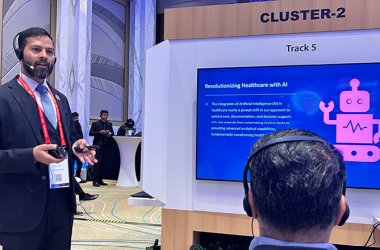Sujay Patil, Regional Director – MEA, Kissflow, on how low code and Gen AI are coming together to revolutionize app development.

Can you tell us about the ongoing transformation of the application development paradigms and why this is important to businesses?
Today, applications are the enablers of business for the enterprise – from helping employees operate more effectively, to empowering customers to conveniently access services. Enterprises that embrace custom apps have an easier and more reliable way of running their everyday business processes.
However, the rising expectations from innovation-craving customers and the need to quickly meet market changes have increased demand for custom apps, creating severe IT backlogs across industries. In fact, the market demand for app development is expected to grow at a pace that is 5x faster than IT can deliver.
While the traditional software development approach worked before, organisations can no longer rely on their IT teams solely to manage the growing demand for custom business apps. This is a challenge that will only be exacerbated by the US$50 billion digital skills gap that the UAE is expected to experience by 2030.
This is why organisations are increasingly adopting the Low-code and No-code paradigm. This approach to software development requires little to no coding to build applications and processes. Instead of using complex programming languages, even business users can employ visual interfaces with basic logic and drag-and-drop capabilities in a low-code development platform. In this way, users with no advanced knowledge of coding or software creation may use these intuitive techniques to build software for several purposes, such as creating mobile and business applications.
These technologies give enterprises the foundation to scale their development efforts by including business users in the app development process, paving the way for future growth. And the benefits are clear – according to Forrester, Low-code and No-code development platforms can speed up software development time by up to 10 times compared to traditional coding methods. They can enable changes quickly and allow for scalable business adoption through many potential use cases.
What are some of the things Low-code and No-code can help enterprises with?
The major concern that enterprises have been facing globally is that they are not able to cater to the demands and requirements of their business users. These organisations have been spending huge amounts for procuring enterprise solutions to streamline their operations. However, what return they get is a more complex IT environment which themselves takes multiple years to be implemented. The solutions, though powerful, are not able to provide the impact that the customers require.
Low-code and No-code tools are the answer to this challenge. This paradigm is changing the way businesses create software and opening up a whole new pool of qualified resources – citizen developers. Because these employees are also the actual target user group for the applications, they are best positioned to know what features and functionality will best serve their needs. Consider a typical finance department which has numerous processes in place for functions like vendor onboarding, accounts receivables, payables and more. Even today, these processes are largely manual – reliant on paper-based forms and email-based communications and reminders. If instead, the business users within the finance department could be empowered by Low-code to automate the processes within the department, the improvements to operational efficiency and employee satisfaction could be significant.
Extend this ability across all departments in the enterprise, and suddenly the journey towards true and impactful digital transformation is greatly accelerated with all employees having the opportunity to be stakeholders in the process.
We have already seen examples of ChatGPT being used to generate code. Is there scope for AI and Low code and No code to co-exist, or does generative AI make the latter redundant?
Generative AI has already demonstrated its potential to be a significant disruptive force in this market. It makes the interface between humans and computers intuitive and frictionless. For these reasons, rather than replacing, it is heralding the next evolution of Low-code and No-code platforms. When combined with Low-code, it holds the ability to seamlessly connect end users with systems, enabling the creation of applications without any prior knowledge of coding, including fundamental elements like forms and fields.
At Kissflow, we are currently executing on our strategy of deeply embedding generative AI into our platforms and thus democratise application development. For example, we have added Gen AI features such as AI suggested fields to assist users in quickly creating processes and applications.
Innovation is now paramount to providing businesses with a competitive edge. How are AI and Low-Code coming together to accelerate the ability of enterprises to innovate?
A: The convergence of generative AI and Low-code enables systems to manage the work rather intuitively. This ‘power of two’ is going to bring a lot of possibilities for the enterprise. As AI and low-code technology come together, the development gap closes. Low-code software increases the accessibility of development across organisations (i.e. citizen development) while generative AI increases organisational efficiency and congruence.
Low-code and no-code application development platforms allow non-technical users or no-coders to reimagine and digitise their business processes without obtaining steep IT experience or spending exorbitantly on IT infrastructure. Combining AI with Low-code platforms can help organisations solve potential business problems faster and more efficiently. As the benefits of a visual drag-and-drop editor are combined with AI models, end users can choose between using visual elements or natural language processing for app development.
Low-code platforms can also offer chatbot-like interfaces to assist developers throughout the development process. Similarly, AI can produce multimedia assets or text for applications to accelerate the development process further.
AI can accelerate the entire Low-code application development process, reduce errors with automation, decrease development time, and improve overall quality. Most importantly, it can further reduce the learning curve for low-code platforms.
According to McKinsey analysts, “The direct impact of AI on the productivity of software engineering could range from 20 to 45 percent of current annual spending on the function.” It is clear that the convergence of AI and Low-code is a trend we will see more commonly in the years to come, and one that will deliver incredible value to businesses as they continue to digitally transform.





